Monitor vs drones
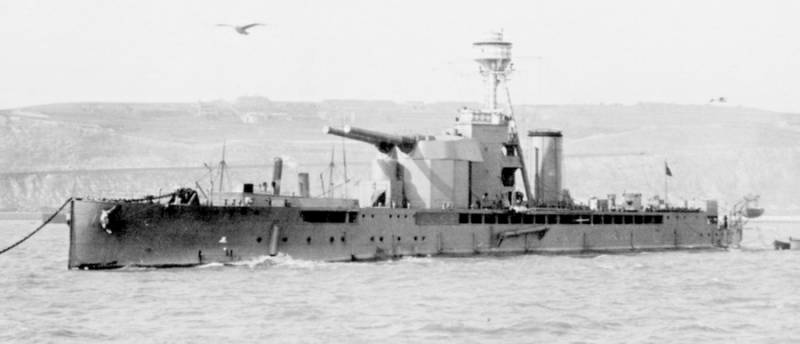
Erebus monitor in Dover harbor in 1917
and no great ship will pass."
Isaiah 33:21
History weapons. Today application drones with a warhead on board, no one can be surprised. Moreover, these can be aircraft, and remotely controlled boats, and even obsolete ones loaded with explosives. Tanks and BTR. But everything that is thought up today, once already was before.
Perhaps what was created before was not as perfect as what is done today, but, in spite of everything, these “notions” worked. And they became the first, and maybe the second or even the third (who counted them?) step to the current perfection. And now, when a variety of technical innovations are used in the course of the CBO, we will now tell you about one such development ...
And it happened that even during the First World War, the British had to re-engage in the construction of monitors that could operate off the coast where "a large ship would not pass." The most powerful ships of this type in English navy were monitors "Erebus" and "Terror", the order for the construction of which was received in 1915.
Erebus, which we, in fact, will discuss, was built at the Harland and Wolf shipyard in Govan (Glasgow region), in the same place where the ill-fated Titanic was also built.
They built the ship quickly, paying attention to ensuring good seaworthiness and speed. And, careful study of its contours played a role: during the tests, the ship was able to develop a speed of 14,1 knots, while the power of its car was 7 hp. With. By the way, "Erebus" was the fifth ship of the British Navy, which bore this name.
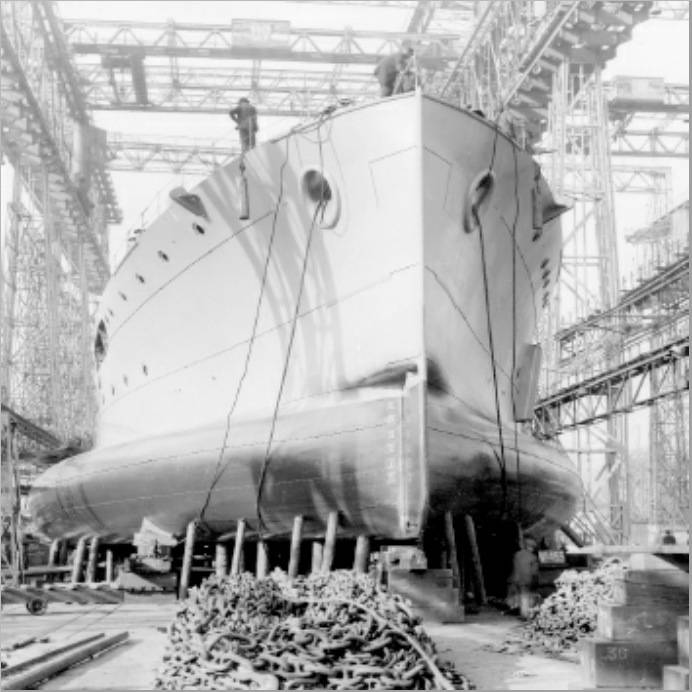
"Terror" on slipway No. 3 of the shipyard "Harland and Wolfe" in Belfast. It was here that the monitor "Lord Clive" and the liner "Titanic" were built. Pay attention to the downright huge boules along the sides, running almost along the entire monitor body
The beginning of the First World War was marked by the death of several British ships at once from torpedoes. Therefore, for monitors that were supposed to operate off enemy coasts, where they could be subjected to torpedo attacks by both destroyers and submarines, as well as run into mines, protecting the hull from underwater explosions became a priority.
A section of the side of a merchant ship was tested and determined that a 350 meter (157 ft) wide boule would suffice to be protected against a 3 lb (10 kg) charge. Inside the hull, sealed steel tubes showed the best results.
Then the charges were blown up at the side of the unfinished battleship and found out that with a boule width of 2,3 meters, it can withstand the explosion of a 400-pound charge (180 kg), while the pipes inside were crushed, but the board itself was practically not damaged. Therefore, it was decided to "reward" the new ships with just such boules, designed to provide them with complete protection against the then torpedoes.
In addition, inside the boules were also divided by transverse bulkheads into as many as 50 compartments, which further strengthened anti-torpedo protection.
In general, the ship turned out and, moreover, was considered one of the most powerful ships in its class in the Royal Navy of the First World War. He could engage in battle with a cruiser, and even for shelling the coast of his weapons were more than enough. The seaworthiness of the ship was also considered by specialists to be very good for a ship of this class.
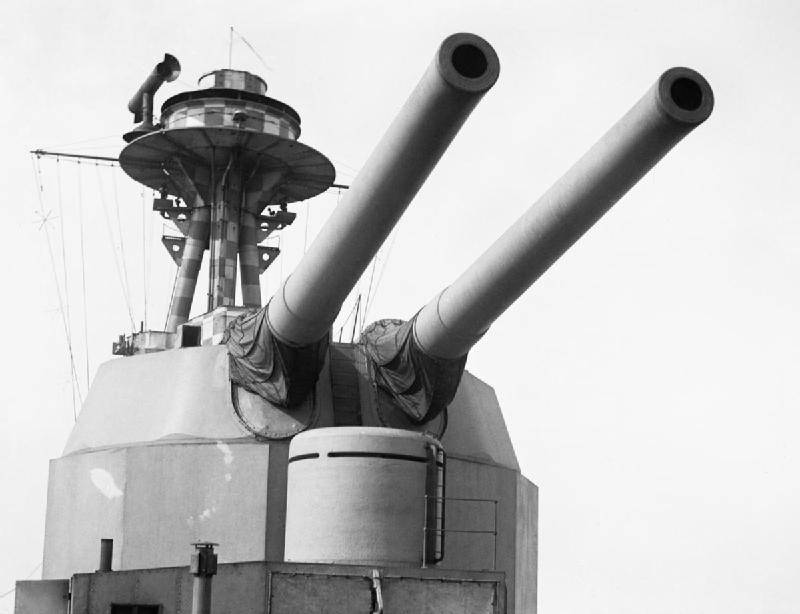
The tower with 381-mm guns of the Terror monitor, and exactly the same and with the same guns, stood on the Erebus. A conning tower with narrow horizontal slots is visible in front of the tower.
The armament of the Erebus was exceptionally powerful compared to other monitors and consisted of two 381-mm guns of the Mk I model in a turret in the forward part of the hull. Auxiliary caliber - 152-mm guns, stood on the deck behind the armor shields.
Due to the fact that the monitor tower was mounted on a high barbette, which, in turn, made it possible to increase the elevation angle of the gun barrels, it was possible to maximize the firing range of the main caliber, which was about 36 meters.
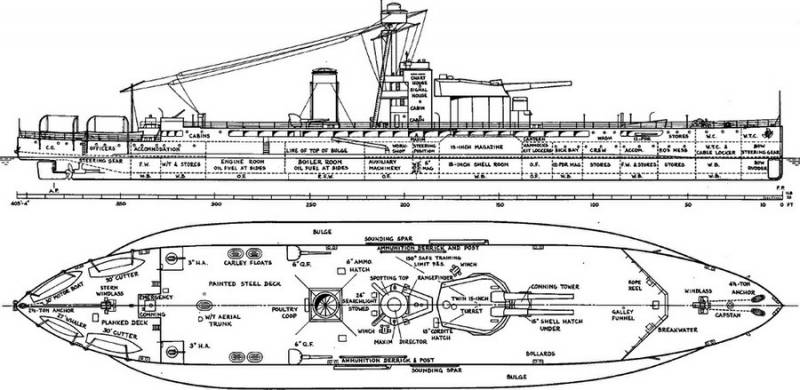
Armor scheme of the Erebus monitor. Interestingly, another rudder was provided in the bow of the hull to increase maneuverability.
The armor was quite solid and on the sides was 102 mm, which guaranteed protection against medium-caliber projectiles at any distance.
The monitor was put into operation in September 1916 and was immediately sent to serve where it was most expected - to support the flank of the British army, resting on the sea off the Belgian coast, with fire. The combat work of the monitor was to conduct regular shelling of German positions near Zeebrugge.
The Germans could do almost nothing to counter strikes from the sea. They attacked his sistership "Terror" with torpedoes from destroyers, but even if three torpedoes hit the side, they could not sink it! Therefore, it was decided to use the most modern and, in fact, experimental weapons at that time against Erebus - an exploding boat controlled by radio. At that time, the development of such boats, which had the designation FL-12 (Fernlenkboot, which literally means "remote-controlled boat"), was carried out by Siemens.
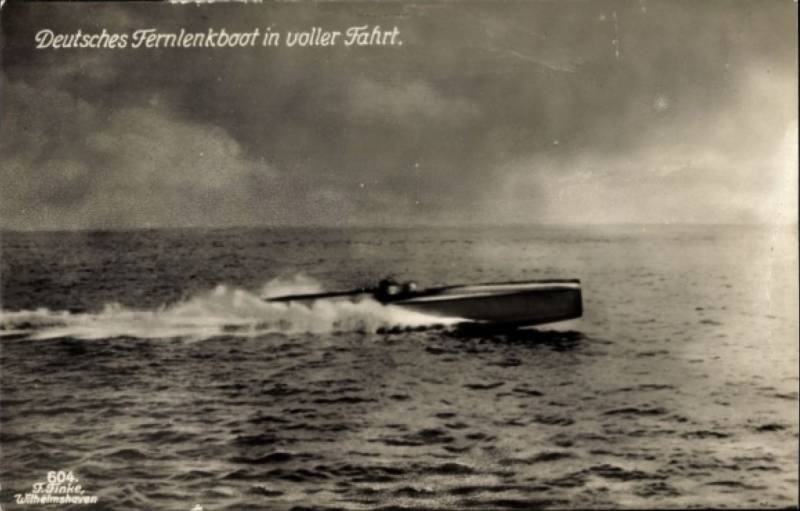
German FL-12 goes on the attack!
The German superweapon was a 17 m long motorboat loaded with 700 kg of explosives, which was specifically designed to aim at Royal Navy monitors off the coast of Flanders. The boats were equipped with internal combustion engines and were controlled by wire from the shore. The length of the wire was 20 kilometers, and the coil itself with wires weighed 800 kg. It was possible to use an airplane to transmit signals to the coast station by radio.
The commands that the operator could execute were as follows: check the system, start the engine, stop the engine, set the rudder, turn on the lights so that the boat could be tracked in the dark, detonate the charge in case the boat was captured if it did not hit the target. The boats could reach speeds of up to 30 knots (56 km/h).
On March 1, 1917, an FL boat crashed into the Newport pier, and on October 28, 1917, the boat attacked the Erebus monitor, thus becoming the first ship in history to be attacked by a remotely controlled combat device.
On this day, the Erebus was 40 miles away from the Belgian port of Ostend. Naturally, the German command knew about the presence of a British monitor in that area and decided to use a remotely controlled exploding boat against it.
In this case, the boat involved was carrying not 700, but 230 kg of explosives. He went to sea at 13:20 and at first 25 minutes was controlled by wire from the shore, and then the aircraft took control of the boat, at 14:18 sent it to the monitor. FL-12 struck "Erebus" almost in the middle of the side. But a large explosion could not inflict fatal damage on the monitor, although it did a large hole in its bule. But the board was not broken. Therefore, the monitor returned to the base under its own power, and was repaired for only two weeks.
So it can hardly be considered a success. But the example itself was very revealing. The British were unable to sink the attacking boat, and most likely did not even understand what it was. And if he had not 230, but 700 kg of explosives on board, the damage from his detonation could be much more serious.
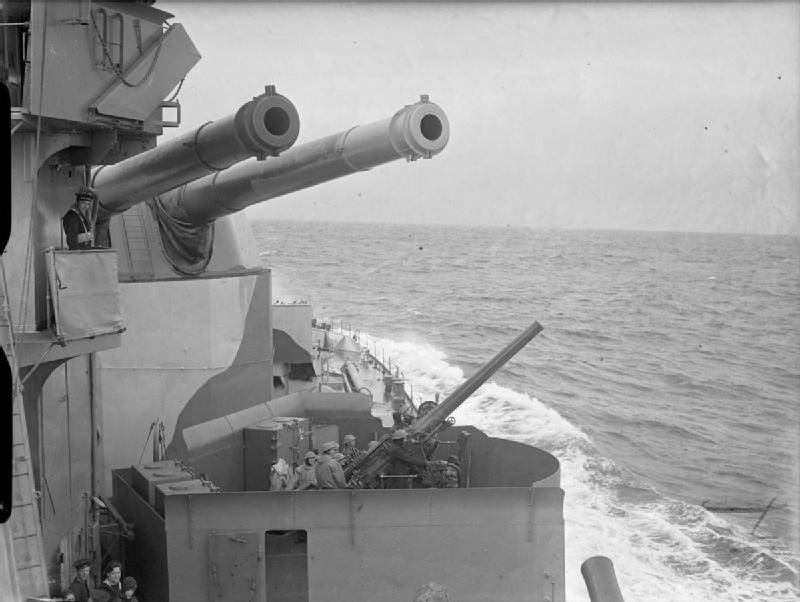
Erebus main battery guns and 4-inch anti-aircraft gun
So this explosion did not affect the military career of Erebus. In 1919, he was involved in the Baltic and the White Sea, participating in the intervention against Soviet Russia, and after the outbreak of World War II in October 1940, he fired at German positions at Dunkirk. Sent in 1942 to the East, he participated in the battles with the Japanese near Ceylon, was damaged, and then repaired in Bombay.
Returning from the Indian Ocean at the end of 1942, he was sent to the Mediterranean in 1943, where he provided artillery support for the Allied landings in Sicily and southern Italy. In July, he fired on German troops in the Syracuse region, and in September he supported the landing of the British in Calabria.
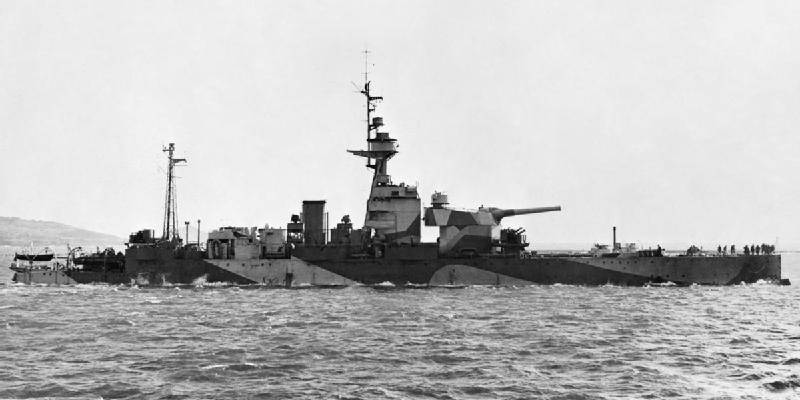
Erebus in 1944
Erebus also took an active part during the landing operation in Normandy ... On August 10, in a battle with the coastal batteries of Le Havre, he was damaged and was out of action for some time. Nevertheless, he showed excellent shooting results: 30 shells out of 130 fired hit enemy targets.
After the end of the war, they again wanted to send the monitor to the East, but in 1946 it was written off and in 1947 it was scrapped. On this, the fate of the ship - the first victim of remote-controlled weapons, ended successfully!
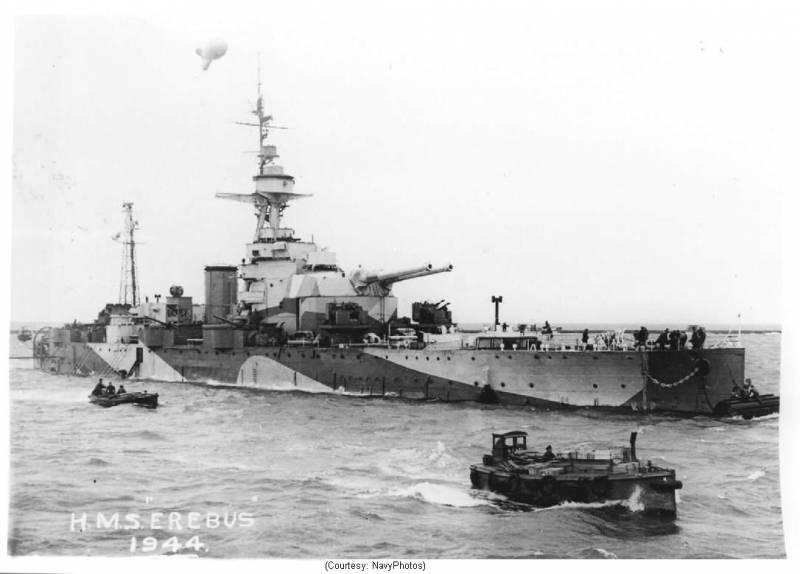
Another photograph of an Erebus monitor in 1944 with Wilkinson's distorted coloration. Two anti-aircraft "pom-poms" are visible under the main caliber tower
PS
Photographs from the Imperial Archives of the War Museum were used as illustrations.
Information